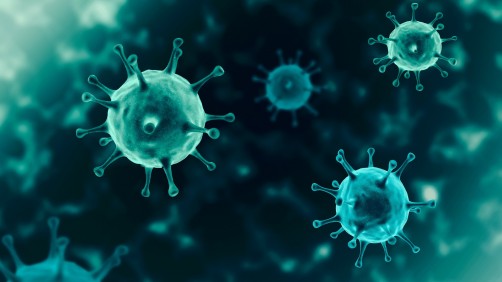Illustration of the SARS-CoV-2 virus, which causes COVID-19, floating in a host cell. Researchers have uncovered details about how the virus camouflages itself inside a cell, evading detection from the immune system. Image by Nhemz/Shutterstock
Scientists using the Advanced Photon Source have discovered new insights into the ways the SARS-CoV-2 virus camouflages itself inside the human body.
Scientists around the world have been working for months to identity and develop treatments that combat SARS-CoV-2, the virus that causes COVID-19. An important part of that process is understanding how the virus evades detection inside the human body, camouflaging itself to hide from the body’s immune system.
A team of researchers using the Advanced Photon Source (APS), a U.S. Department of Energy (DOE) Office of Science User Facility at the DOE’s Argonne National Laboratory, has revealed insights into the mechanism the virus uses to elude the immune system. This pivotal discovery was published in Nature Communications.
“The virus uses the classical mechanism of camouflaging and exploiting the host machinery for its own protein synthesis. It goes inside the host cell and its messenger RNA looks the same as the host messenger RNA.” — Yogesh Gupta, assistant professor, University of Texas Health Center at San Antonio
“A lot of researchers are looking at how the virus enters a cell,” said Yogesh Gupta, assistant professor at the University of Texas Health Science Center at San Antonio and corresponding author on the paper. “We wanted to look at what happens when it is inside the cell. How does the virus survive and evade immune mechanisms?”
To do this, Gupta and his team examined two of the SARS-CoV-2 proteins, known as nonstructural proteins 10 and 16, using the ultrabright X-rays generated by the APS. The work was performed at the Northeastern Collaborative Access Team (NE-CAT) beamline, number 24-ID, which is managed by Cornell University.
They discovered that the SARS-CoV-2 virus uses some unique ways to camouflage its messenger ribonucleic acid (RNA), the single-stranded molecule that carries the genetic code for synthesizing proteins, to mimic those of the host cell. The immune system cannot differentiate it from the body’s own messenger RNA, so it doesn’t fight the virus off.
It is a little like wearing a blue-collared shirt to Best Buy. You may not work there, but people will treat you like you do, in the same way that a host cell’s immune system will treat the virus like it belongs.
“The virus uses the classical mechanism of camouflaging and exploiting the host machinery for its own protein synthesis,” he said. “It goes inside the host cell and its messenger RNA looks the same as the host messenger RNA.”
Gupta said this process was thought to be similar to those seen in previous coronaviruses, but his team observed some unique features in the SARS-CoV-2 protein. Understanding how this particular virus uses this protein to avoid detection will help with designing new treatments. What’s needed, he said, is a drug that targets the virus, not the host, and knowing more about the camouflage mechanism will help develop one.
The research team also discovered a unique pocket in the structure of the proteins, one that is not present in previous coronaviruses. This pocket, Gupta said, may be a strong target for antiviral development.
NE-CAT is one of 16 beamlines at the APS that have dedicated a significant portion of beam time to COVID-19 research, using a technique called macromolecular crystallography. This involves diffracting X-ray beams off of crystals grown from synthetic proteins — APS scientists do not work with the live virus — to precisely determine their structures, often in complex with drug candidates or other chemicals.
The research team accessed the NE-CAT beamline remotely, operating it through a computer interface. Remote and mail-in experiments have been the focus of the APS since March, as a result of the COVID-19 pandemic. But scientists using NE-CAT are likely used to the interface, since 95 percent of the beamline’s research is carried out remotely, according to Frank Murphy, associate director of NE-CAT and a senior research associate at Cornell.
“The APS is a great place to do photon science,” Murphy said, “and it’s the best place in the world to do macromolecular crystallography. We have so many good people and good beamlines.”
Gupta’s team has been using the APS since 2007, employing various X-ray techniques to uncover insights into biological structures.
“The APS is a unique facility that allows us to measure X-ray diffraction data precisely and quickly,” he said. “We are fortunate to have a relationship with the APS, and it has allowed us to further our knowledge of the basic mechanisms of this virus.”
Source: Argonne National Laboratory

Be the first to comment on "Hide and Seek: Understanding How COVID-19 Evades Detection in a Human Cell"